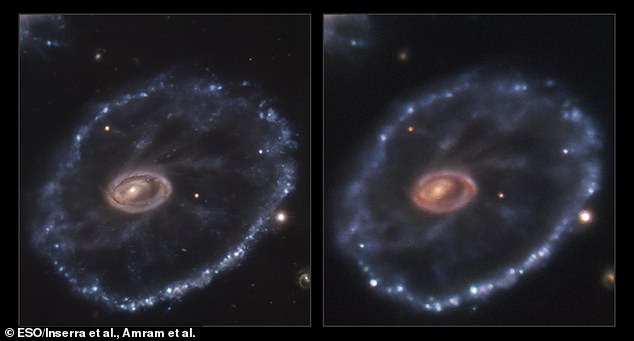Astronomers have captured the moment a star, 500 million light-years from Earth, exploded in a dramatic supernova, marking the end of its life.
A type II supernova explosion occurs when a very large star cannot fuse atoms within its core, causing it to explode, shedding its outer layers.
The supernova, called SN2021afdx, occurred in the unusually shaped Cartwheel galaxy, which is located in the constellation Sculptor.
Astronomers captured the image in December 2021 using the European Southern Observatory’s (NTT) New Technology Telescope in Chile.
They then compared the image to one from the same galaxy, taken with the Very Large Telescope (VLT) in August 2014 – before the supernova explosion occurred.
A new bright light can be seen in the lower left side of the new image, this is not visible in the 2014 image.


Astronomers have captured the moment a star, 500 million light-years from Earth, exploded in a dramatic supernova, marking the end of its life. The left image is from 2014 before the explosion, and the right is from 2021, with the explosion at the bottom right
Light from a star explosion can be visible months or even years after the event, although it was observed in December 2021, the supernova explosion occurred 500 million years ago – it took that long for the light to reach Earth.
It lies within the Cartwheel Galaxy, which was once an ordinary spiral galaxy that underwent direct interaction with a smaller companion galaxy several million years ago, giving it its distinctive appearance.
SN2021afdx was a Type II supernova, which occurs when a massive star reaches the end of its evolution and leaves behind a black hole or neutron star.
Supernovae are one reason astronomers say we are all made of star dust, because they leave the space around them full of heavy elements. These elements form as a young star, which may later give rise to generations of new stars and planets.


The supernova, called SN2021afdx, occurred in the unusually shaped Cartwheel galaxy, which is located in the constellation Sculptor.
Detecting and studying these unexpected events requires international cooperation across multiple telescopes.
These observations must occur over many years – to detect differences in the night sky – because, although seen for several months, they can be fleeting.
The first time SN2021afdx was observed was in November 2021 by an ATLAS survey.
Atlas is an asteroid impact early warning system developed by the University of Hawaii and funded by NASA.
It consists of four telescopes, two in Hawaii, one in Chile and a fourth in South Africa. Each of them automatically scans the entire sky several times each night for moving objects. They can be used to discover the supernova.
After Atlas discovered the supernova, the European Southern Observatory pointed ePESSTO+ at the object, the ESO General Spectroscopic Survey of Transient Objects, designed to study transient events such as a supernova.
Not only did they capture the beautiful image of the galaxy, and the supernova – in the lower left corner of the structure – but also the spectra. Astronomers can use these spectra to determine if it is a type II supernova.
The Cartwheel Galaxy, which hosts this new supernova event, is a lenticular and ring galaxy – estimated to be about 150,000 light-years in diameter.
It is a major part of the Cartwheel group of galaxies, with four spiral galaxies – three companions and the Cartwheel galaxy itself.
A supernova occurs when a giant star explodes
A supernova occurs when a star explodes, releasing debris and particles into space.
A supernova only burns for a short period of time, but it can tell scientists a lot about how the universe came to be.
One type of supernova showed scientists that we live in an expanding universe, a world that is growing at an ever-increasing rate.
Scientists have also determined that supernovae play a major role in the distribution of elements throughout the universe.


In 1987, astronomers spotted a “giant supernova” in a nearby galaxy blazing with more power than 100 million suns (pictured)
There are two known types of supernova.
The first type occurs in binary star systems when one of the two stars, a white dwarf of carbon and oxygen, steals matter from its companion star.
Eventually, the white dwarf accumulates a lot of matter, causing the star to explode, resulting in a supernova.
The second type of supernova occurs at the end of a single star’s lifetime.
As the star runs out of nuclear fuel, some of its mass flows into its core.
Eventually, the core is too heavy to withstand its own gravitational force and the core collapses, resulting in another giant explosion.
Many of the elements on Earth form in the core of stars and these elements are carried over to form new stars, planets, and everything else in the universe.

